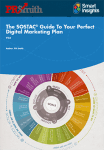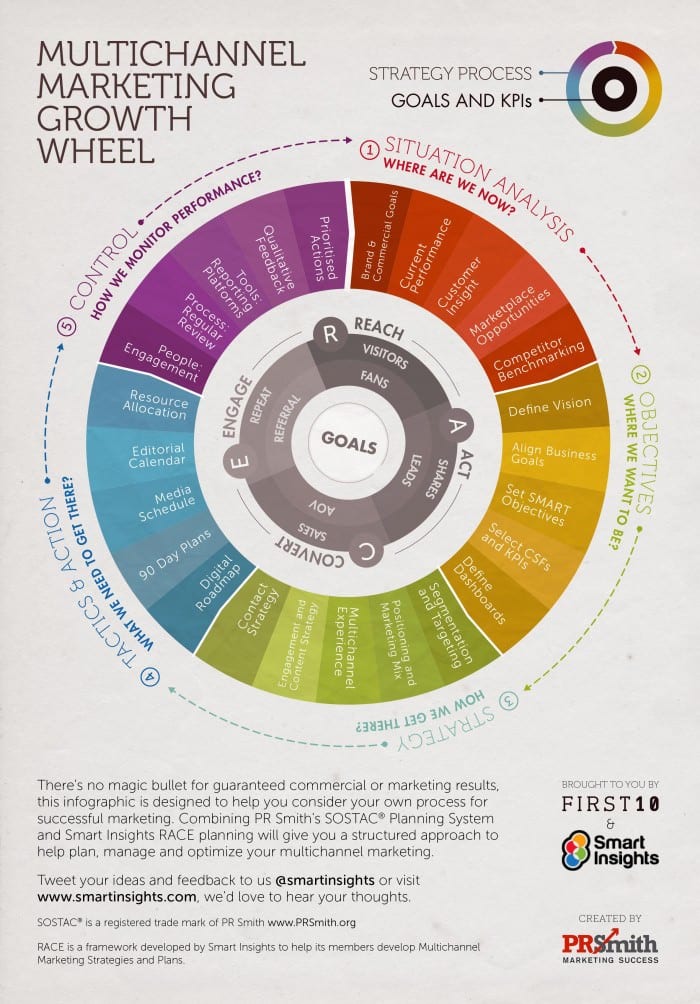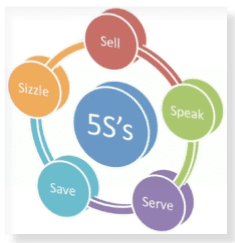A SOSTAC® Plan example


How to create a digital marketing plan using PR Smith’s SOSTAC® Planning model
SOSTAC is a widely used tool for marketing and business planning which is rated in the top 3 most popular marketing models in the Smart Insights review of Marketing Models that have stood the test of time.
In this post I give an example of how I have applied PR Smith’s SOSTAC® Planning Model – which is my interpretation of SOSTAC®.
Further guidance and examples are available in the Smart Insights guide for Expert members by PR Smith and this post by Dave Chaffey giving an overview of the SOSTAC® model.
Download resource – Creating a Digital Marketing plan with SOSTAC®
A guide for Expert members to creating a digital marketing plan using SOSTAC® by PR Smith, the creator of the method. Now updated for 2016.
Access the SOSTAC® Digital Marketing Planning Guide
Originally created in the 1990s by writer and speaker PR Smith, the SOSTAC® framework has built an authoritative reputation as the framework of choice for different scales of business including multinational and startup organisations across the world.
The SOSTAC® process covers six key areas which I’ll explain in this post:
- Situation Analysis
- Objectives
- Strategy
- Tactics
- Action
- Control
If you’re looking for a visual example, the process for creating a digital marketing plan has also been summarised in this Multichannel Marketing Plan infographic. My recommendations cover many of these planning and management activities, but not all, due to space.

Stage 1. Situation Analysis
Stage 1 of implementing this digital marketing planning framework is setting out the situation analysis. The situation should provide an overview of your organisation – who you are, what you do and how you interact and trade online by addressing internal and external factors impacting the business.
This section should be painting a picture of your organisation and to do this, consider using some of the following methods to bring this section to life:
Below I’ve gone into a bit more detail for a few of these areas:
Digital Customers
An analysis of who your digital audience is should be defined in a section. This is essential to ensure you’re providing a clear picture of existing customers and who you are looking to also target. If you’re operating in a competitive environment, consider including what your online value proposition (OVP) is should you have one?
For example, how do you envision your organisation to differentiate itself from the competition? To help define your organisations OVP, David Chaffey recommends the 6Cs of customer motivation framework.
Customers Personas
Creating customer personas helps brings to life who your existing customers are and what their motivations are. Persona creation also helps to get buy-in across your organisation in helping to paint a picture and bring to life your customer profiles. To create a series of personas, a majority of this work can be completed by extracting existing data through your CRM system and analytics and then build on this to create a profile picture of your existing customers.
For an e-commerce retailer, information you could consider extracting from your CRM could include:
- Male/Female Split – What is the percentage split?
- Age profiling – Average age as well as being able to develop categories of age groupings
- Location/Address details – Percentage of customers who reside in the UK as well as overseas
- Purchase history – Build up a clearer picture on historical purchases, average order value, trends in brand loyalty, products ordered by size
- Method of purchase (e.g. credit card, debit card, cheque)
- Route to purchase – Were purchases made through a search engine, email newsletter, affiliate website, direct from site or through the call centre, i.e. Mixed-mode
- Frequency/Recency – Frequency of purchase?
Fictional Online Retailer to show how personas work
Based on this data, the next stage is to turn this data into more of a personality that your organisation can relate to. For example, I’ve created 2 x personas for a fictional online retailer:
Persona A:
Steve is a 28 yr old professional, renting in London, single and with a high disposable income. He has a keen interest in football and supports a premiership football team. He likes to display his support for his football club every year, buying the clubs latest replica shirt online.
Steve is comfortable in ordering online and engaging with social media to keep up to date with the latest football news and football product launches. As the World Cup provides the chance to showcase international replica shirts, this provides Company X with the chance to engage with Steve to make an additional purchase of an international replica shirt as well as purchasing his favourite club shirt.
Scenario:
Steve has been reading the latest new stories regarding the World Cup through his favourite football blog site. Steve notices the blog has an exclusive promotion to order any World Cup football shirt of your choice from Company X and save 10% by clicking on a link to www.companyx.co.uk/worldcup. Steve clicks on the link and arrives at Company X which brings up a list of World Cup shirts available to order displaying the exclusive 10% discount promotion. Steve chooses the shirt of his choice in his preferred shirt size and completes a transaction using his credit card.
Persona B:
Clare is a 33 yr old professional who is in a relationship. She likes to keep up with the latest fashion trends and is comfortable in ordering at her favourite online shop. Her boyfriend is a keen football fan who likes to keep up with football fashion by purchasing the latest football replica shirts of his favourite team. Clare may engage with the hype of the World Cup and this could provide an opportunity to for her to make and purchase at Company X for her boyfriend and the International team they choose to support during the tournament.
Scenario:
Clare has received an email from one of her preferred online retailers which includes a cross marketing promotion to Company X, where you can order your World cup shirt by quoting a promotional code. Clare thinks this would make a great gift for her partner and decides to click through to www.companyx.co.uk. She is unsure of the team and shirt to order so decides to phone the order helpline and take advantage of mixed-mode buying. Clare explains her situation over the phone to the sales consultant and places her order over the phone for the football shirt.
You can see more examples and guidance in the Smart Insights Persona Toolkit.
SWOT analysis
It’s worth considering creating a SWOT analysis of your organisation, thinking laterally by embracing all your internal departments rather than just focusing on the digital marketing department and gathering evidence and interviews on your colleagues, suppliers, customers thoughts.
Not only will it provide a better picture to lay out a strategy for your organisation as a whole but it also provides you with the opportunity to interview and build relationships across the organisation.
Dave Chaffey has examples of a marketing SWOT examples in his post where he recommends the TOWs matrix method to link the SWOT forward to strategies.
Stage 2. Objectives
Stage 2 of your digital marketing planning framework should focus on the Objective/s of your strategy. Stage 1 looked at the situation analysis which provided an overview for your organisation, specifically: who you are, what you do and how you interact and trade online by addressing internal and external factors impacting your business.
To help create your objectives, I recommend you use two guides to help to create both measurable and realistic goals to achieve for your digital marketing strategy, focusing on the 5 S’s and ensuring you make each objective SMART.
 The 5 Ss goals refer to: Sell, Serve, Speak, Save and Sizzle which were created by PR Smith and the concept first published it in various online elearning packages and reference can also be found in the book, Emarketing Excellence . From defining your objectives relating to the 5 S’s to make it measurable, it is important to turn each objective into SMART objectives, which stands for:
The 5 Ss goals refer to: Sell, Serve, Speak, Save and Sizzle which were created by PR Smith and the concept first published it in various online elearning packages and reference can also be found in the book, Emarketing Excellence . From defining your objectives relating to the 5 S’s to make it measurable, it is important to turn each objective into SMART objectives, which stands for:
- Specific – Are you focusing enough on a specific issue or challenge within the organisation?
- Measureable – How do you plan to assess the performance? Will it be monitored through quantitative or qualitative analysis for example?
- Actionable – Will it assist in improving performance if achieved?
- Relevant – Is the issue to be addressed within the domain of the digital marketing team?
- Time-related – Have you set a specific time period?.
There are a number of different SMART objectives that can be set for example, lead generation, acquisition or engagement or retention. For example, if we revisit the fictional online retailer, we can create the following objectives that have been created to follow the SMART formula:
- Objective 1. Engagement: Achieve 50% of existing customers to service their online account by July 2015.
- Objective 2. Acquisition: Increase brand visibility from April 2015 through to July 2015. To be measured through Google analytics.
- Objective 3. Engagement: Increase email frequency from one email per quarter to one email per week from May 2015 through to July 2015.
Stage 3. Strategy
Strategy means how do you plan to get there in terms of fulfilling the objectives set. The strategy section should also identify which segments of the market you aim to target with your plan.
We have already identified Company X will be focusing on its key strengths: product range, organisational structure and global operations (as detailed in the SWOT analysis) whilst remaining realistic to its lack of financial resources in comparison to the competition.
It is recommended Company X to develop a site geared for the World Cup which will provide a dedicated section used to service the customer base and to meet and service the objectives set for the strategy. The site will act as a key differentiator from the competition and a reason to visit and carry out a transaction. The strategy will be to outflank competitors in order to grab market share for world cup online traffic.
To summarise the Objectives set, specific questions have also been raised below to be considered within the strategy:
- 1. Acquisition
Increase brand visibility from April 2015 through to July 2015. To be measured through Google analytics. Increase the brand presence within identified online channels that target the football fan audience. What is the most cost-effective route to market? Are we reaching our key customer segments? Where can the brand name get increased exposure? Research our competitors and understand what online marketing tools they are using as well as not utilising and take a first mover advantage.
- 2. Engagement
Achieve 50% of existing customers to service their online account by July 2015. Understand our existing customer database and how they interact with the website.
- 3. Engagement
Increase email frequency from one email per quarter to one email per week from May 2015 through to July 2015. How is the company currently communicating with its existing customer database? Who of our competitors have implemented a communication with their customers?
Dave Chaffey recommends you use this type of table to summarise how you link or align strategy with objectives.
Stage 4. Tactics
Tactics cover the specific tools of the digital mix that you plan to use to realise the objectives of your digital marketing plan. The strategy section should also identify which segments of the market you aim to target with your plan.
We have already identified Company X will be focusing on its key strengths: product range, organisational structure and global operations (as detailed in the SWOT analysis) whilst remaining realistic to its lack of financial resources in comparison to the competition.
It is recommended Company X develop a micro site geared for the World Cup which will provide a dedicated section used to service the customer base and to meet and service the objectives set for the strategy. Competitor research was completed in stage 1, situation analysis, and a micro site will act as a key differentiator from the competition and provide the foundation to meeting the objectives of the strategy.
To summarise the Objectives set, specific questions have also been raised below to be considered within the strategy:
- Objective 1. Engagement: Achieve 50% of existing customers to service their online account by July 2015.
- Objective 2 Acquisition: Increase brand visibility from April 2015 through to July 2015. To be measured through Google analytics.
- Objective 3. Engagement: Increase email frequency from one email per quarter to one email per week from May 2015 through to July 2015.
Marketing mix to focus on your objectives
To help achieve the objectives above, use the 7PS of the Marketing Mix to focus on the key attributes to be considered by Company X in order to meet youe objectives. The marketing mix also provides a checklist of key areas to focus on:
Product – Company X enjoys global accreditation with the leading sports manufacturers. It therefore needs to ensure sufficient stock levels have been secured for each team playing at the World Cup finals.
Price – Review pricing of World Cup products and to ensure it is consistent to online competitors.
Place – Operating as an online retailer, this provides the main hub for all stock movements utilising courier companies to increase efficiency in delivering stock to the customer in the quickest time possible.
Promotion – Can utilise many of its online marketing tools available to utilise its effectiveness in promoting the product range to create a unique selling point (USP):
- Email marketing: Through past purchase history, set up targeted emails to send to existing customers based on team they support. Drive team specific promotions within each email e.g. Buy One Get One Free products, unique discounts on product lines. Also push refer a friend emails with incentive e.g. Send this email to five of your friends and if they register you get a 15% discount off your next order.
- Online voucher codes: Set up voucher codes that offer a 10% discount which are time specific to provide reporting (e.g. does the voucher include an expiry date).
- Social Media: Utilise the company accounts to engage with other football news accounts and provide information on latest World Cup products and promotions.
People – Utilise the customer service team to engage with customers should it be needed to provide support for customers who would like to answer questions on delivery of their order, tracking their order. Introduce Live Chat to allow existing and new customers to engage with staff.
Process – The customer would be directed to the website through a referral or recommendation. Locate the product of interest and add to shopping basket. Register your details online and add your credit card details to complete purchase. The customer will then receive an automated email response to confirm their registration along with an email to confirm order. A separate email will be sent to notify the customer when the order has been despatched.
Partnerships – List important strategic relationships with other companies that operate in non-competing sectors that have become an important selling point to differentiate itself from other online competitors.
Marketing tactics
When completing your own strategy, you would be going into a lot more detail for each tactic along with specific KPIs for each tactic
Tactic 1: SEO
From the competitor analysis, one of the key weaknesses of Company X over its competitors was a lack of financial muscle. However SEO does provide the company with a platform to compete head on, specifically, Search Engine Optimisation.
To understand what a positive impact SEO would offer in terms of increasing brand visibility for this target market, a keyword analysis should be performed, specifically on the Google UK marketsince ~90% of all searches in many markets are conducted through Google
Tactic 2: Pay-Per Click
As with SEO, the keyword research will provide a foundation on what keywords to target with a budget. Much of the competition do not operate a PPC campaign, therefore this is an area to capitalise on, by building traffic to the World Cup site as well as to increase brand visibility.
As with SEO, there will be an ongoing refinement of keywords to target as well as budget to allocate per keyword. Due to stock fluctuations, keyword budgets will need to be paused or activated based on stock volumes and demand for the product.
Tactic 3: Affiliate Marketing
A cost effective vehicle in driving brand visibility for Company X is the launch of a program. Building your affiliate marketing network is a central component to ensure you’re maximising opportunities in generating incremental revenue streams through a network of publishers that are active within your program either through lead generation, display, search or voucher codes.
Tactic 4: Email Marketing
An email strategy needs to be implemented in order to ensure our existing customer base is receiving regular newsletters. Tactics to be employed include a variation on what should be included within the content of the newsletters to ensure we retain a good click-through rate, open rate and conversion to sale. This tactic would be to utilise the existing customer database and incentivise them to recruit friends and colleagues to join the mailing list through weekly campaigns.
Stage 5. Action
Stage 5 of your digital marketing planning framework is focused on how to bring your plan to life, to make actionable measures.
The action section covers what needs to be achieved for each of the tactics listed in the previous section of the SOSTAC® plan to realise the objectives of your digital marketing plan.
Case Study to show tactics used
Continuing with the theme of the football World Cup, we have identified Company X will be focusing on its key strengths: product range, organisational structure and global operations (as detailed in the SWOT analysis) whilst remaining realistic to its lack of financial resources in comparison to the competition.
For the purpose of this case study, the following tactics were listed and below each tactic, actions have been included to ensure each has been considered before launch. This is not an exhaustive list but provides an outline to what should be considered:
- Tactic 1: SEO
Keyword analysis – What keywords are we targeting?
On page optimisation – Of the targeted keywords, we need to optimise the website pages of the micro site to ensure best rankings within Google.
Content – Identifying and reaching out to industry leading bloggers, forums and websites prepared to create guest content and build a relationship to propel your brands proposition around the World Cup.
Link building – Bring together a targeted group of websites to target with similar keywords and are seen as high authority sites.
- Tactic 2: Pay-Per Click
Keyword analysis – What keywords are we targeting?
Budget – What budget has been ring-fenced for PPC?
Landing pages – Do the keywords we are targeting direct customers to the correct webpage.
Product Availability – Are we communicating with our buyers to ensure we are bidding on keywords associated with products available to purchase?
- Tactic 3: Affiliate Networks
Affiliate Program – What is the competition doing? e.g. commission tiers, online marketing tools made available to publishers, volume of affiliates.
Business Development – Have we built up a working relationship with the affiliate program and will they assist in identifying and recruiting key affiliates to the program.
- Tactic 4: Email Marketing
Tracking/Software – Is the email software tool being used effectively? Are we tracking performance of email delivery and tracking email effectiveness such as click through rates, open rates, conversion to sale?
Stage 6. Control
The final stage is to layout how you plan to monitor and measure your performance based on the objectives set at stage 2. The tactics have been considered and your control section is providing you with a series of dashboards tailored for each tactic.
Look to set the KPI’s per tactic that tie back into the objectives set and set up a weekly/monthly set of monitoring dashboards to ensure you are on track to meet the objectives set.
It’s important to also communicate your concerns with the wider team to ensure there is buy-in to the company plan
For further information on PR Smith SOSTAC® planning guide, I recommend you purchase the book, The SOSTAC® Guide To Writing Your Perfect Digital Marketing Plan or Smart Insights Expert members can access it as part of their resources.
Download resources – SOSTAC@ Digital Marketing Planning Guide by PR Smith
A planning framework for creating and communicating plans .
Access the SOSTAC® Digital Marketing Planning Guide
Note from PR Smith: Simon Swan is not yet a registered SOSTAC® trainer/consultant but has been granted permission to use SOSTAC® from the registered trademark owner, PR Smith. Further information regarding registered SOSTAC ® trainers & consultants is available from www.PRSmith.org/SOSTAC.
From our sponsors: A SOSTAC® Plan example



